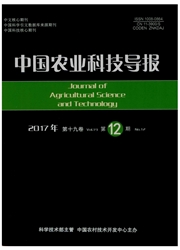

 中文摘要:
中文摘要:
核基因编码的调控因子在光系统Ⅱ(PSⅡ)的组装过程中起着关键的调控或辅助作用。已有研究证明,HCF243蛋白是一个重要的核基因编码的调控因子,推测它可能作为一个辅因子通过与D1蛋白的直接相互作用来维持后者在PSⅡ蛋白复合物中的稳定。为了探究HCF243蛋白在光抑制条件下在PSⅡ核心亚基尤其D1蛋白周转过程中的作用机制,首先利用TAIL-PCR的方法鉴定了hcf243突变体T-DNA的插入位点,并通过半定量RT-PCR对该基因(At3g15095)进行了表达模式分析,发现其表达量在叶中最高并随发育阶段逐渐上调,不同胁迫条件下的表达量也有变化。利用体内蛋白质同位素标记实验,发现hcf243突变体中D1蛋白组装到PSⅡ复合体中的速度明显低于野生型;进一步通过蛋白免疫印记分析证实,在光抑制条件下,相比野生型,hcf243突变体中PSⅡ复合物核心亚基D1降解速度显著加快,可能是造成PSⅡ复合体组装速率降低的原因。因此,通过上述实验推测HCF243蛋白作为一个辅因子,在PSⅡ反应中心D1蛋白的周转尤其降解过程中起着关键的调控作用。
 英文摘要:
英文摘要:
Numerous nuclear encoded auxiliary factors have been identified to play key regulation and assisting roles in the dynamics of photo-system II ( PS II ) complex. Previous research indicated that HCF243, act as a eofactor, could promote the subsequent interaction between D1 and other PS II suhunits, and maintain the stabilization of D1 within PSII complex. In order to explore the roles of HCF243 in PS II under photo-inhibition, we identified the T-DNA insertion site of the hcf243 mutant by TAIL-PCR and analyzed the expression profiles of the gene (At3g15095) by semi-quantitative RT-PCR. Results showed that the transcript abundance of Hcf243 were the highest in leaf and gradually up-regulated as the leaf developed. The transcript abundance also varied under different stresses. Pulse labeling experiments indicated that the assembly rate of D1 protein into PS II complex in mutant hcf243 was much slower than in wild type. Furthermore, the immunoblot analysis of protein complexes revealed that D1 protein decreased severely in hcf243 under photo-inhibition compared to the wild type, which might contribute to the decelerated assembly rate of PS II complex. It could be inferred from our research that HCF243, as a cofactor, was essential for the turnover, especially degradation of D1 protein in Arabidopsis PS II complex.
 同期刊论文项目
同期刊论文项目
 同项目期刊论文
同项目期刊论文
 期刊信息
期刊信息
